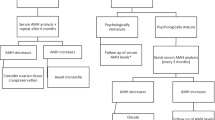Abstract
Purpose
Kallmann syndrome is a genetic disorder characterized by hypogonadotropic hypogonadism and anosmia. We report the case of a 31-year-old woman with Kallmann syndrome who successfully gave birth after intracytoplasmic sperm injection (ICSI) and vitrified–warmed embryo transfer, despite relatively ineffective ovarian stimulation.
Method
A 30 year-old woman with primary amenorrhea wished to achieve pregnancy. Diagnostic testing results were consistent with Kallmann syndrome. Follicular stimulation was started with human menopausal gonadotropin (hMG; 150 IU/day). After 28 days of treatment, 4 follicles were observed (total hMG; 4200 IU), with a dominant follicle diameter of 23 mm. Ovum pick-up was performed and 2 oocytes, one at metaphase II (MII) and one at the germinal vesicle stage, were obtained. Piezo-ICSI was performed on the MII oocyte and an 8-cell stage embryo was cryopreserved on day 3. Subsequently, embryo transfer was performed after endometrial preparation.
Result
A gestational sac and embryo heart activity were confirmed by ultrasonographic monitoring, and a healthy male infant weighing 3246 g was delivered by Caesarean section after 41 weeks 3 days of gestation.
Conclusion
This is the first report of a healthy delivery after vitrified–warmed embryo transfer for a woman with Kallmann syndrome. Our experience suggests that ICSI and vitrified–warmed embryo transfer are effective for women with Kallmann syndrome.
Similar content being viewed by others
References
Battaglia C, Salvatori M, Regnani G, Giulini S, Prinavera MR, Volpe A. Successful induction ovulation using highly purified follicle-stimulating hormone in a woman with Kallmann’s syndrome. Fertil Steril. 2000;73:284–6.
Sipe CS, Van Voorhis BJ. Testosterone patch improves ovarian follicular response to gonadotrophins in a patient with Kallmann’s syndrome: a case report. Hum Reprod. 2007;22:1380–3.
The ESHRE Capri Workshop Group. Intrauterine insemination. Hum Reprod Update. 2009;15:265–77.
Molloy D, Harrison K, Breen T, Hannessey J. The predictive value of idiopathic failure to fertilize on the first in vitro fertilization attempt. Fertil Steril. 1991;56:285–9.
Barlow P, Englert Y, Puissant F, Lejeune B, Delviqne A, Van Rysselberge M, et al. Fertilization failure in IVF: why and what next? Hum Reprod. 1990;5:451–6.
Roque M, Valle M, Guimaraes F, Sampaio M, Geber S. Freeze-all policy: fresh vs. frozen-thawed embryo transfer. Fertil Steril. 2015;103:1190–3.
Diedrich K, Fauser BC, Devroey P, Griesinger G, Evian Annual Reproduction (EVAR) Workshop Group. The role of endometrium and embryo in human implantation. Hum Reprod Update. 2007;13:365–77.
Kuwayama M, Kato O. All round vitrification of human oocytes and embryos. J Assist Reprod Genet. 2000;17:477.
Chang EM, Han JE, Won HJ, Kim YS, Yoon TK, Lee WS. Effect of estrogen priming through luteal phase and stimulation phase in poor responders in in vitro fertilization. J Assist Reprod Genet. 2012;29:225–30.
Iwayama H, Hochi S, Yamashita M. Low stretching ability of human oolemma during piezo-ICSI as a risk factor on post-injection survival and implantation. J Mamm Ova Res. 2010;27:150–6.
Sungurtekin U, Fraser IS, Shearman RP. Pregnancy in women with Kallmann’s syndrome. Fertil Steril. 1995;63:494–5.
Kousta E, White DM, Piazzi A, Loumaye E, Franks S. Successful induction ovulation and completed pregnancy using recombinant human luteinizing hormone and follicle stimulating hormone in a woman with Kallmann’s syndrome. Hum Reprod. 1996;11:70–1.
Chryssikopoulos A, Gregoriou O, Papadias C, Loghis C. Gonadtropin ovulation induction and pregnancies in women with Kallmann’s syndrome. Gynecol Endocrinol. 1998;12:103–8.
Szilagyi A, Manfai Z, Kiesel L, Szabo I. Kallmann’s syndrome: pregnancy through intracytoplasmic sperm injection and complicated by gestational diabetes. Gynecol Endocrinol. 2001;15:325–7.
Nakagawa K, Iwasaki W, Sato M, Ito M, Kawachiya S, Murashima A, et al. Successful pregnancy, achieved by ovulation induction using a human menopausal gonadotropin low-dose step-up protocol in an infertile patient with Kallmann’s syndrome. J Obstet Gynaecol Res. 2005;31:140–3.
Heraud MH, Grenier N, Cabry R, Lourdel E, Sanguinet P, Brasseur F, et al. Management of an ovarian stimulation in a case of Kallmann-De Morsier syndrome. The role of LH. Gynecol Obstet Fertil. 2007;35:548–55.
Yu HT, Lee CL, Huang HY, Soong YK. Successful pregnancy in a woman with Kallmann’s syndrome using human menopausal gonadotropin followed by low-dose human chorionic gonadotropin in the mid-to-late follicular phase. Taiwan J Obstet Gynecol. 2012;51:300–2.
Kastrop PM, Weima SM, Van Kooij RJ, Te Velde ER. Comparison between intracytoplasmic sperm injection and in vitro fertilization (IVF) with high insemination concentration after total fertilization failure in a previous attempt. Hum Reprod. 1999;14:65–9.
Ruiz-Alonso M, Galindo N, Pellicer A, Simon C. What a difference two days make: “personalized” embryo transfer (pET) paradigm: a case report and pilot study. Hum Reprod. 2014;29:1244–7.
Iwayma H, Hochi S, Yamashita M. In vitro and in vivo viability of human blastocysts collapsed by laser pulse or osmotic shock prior to vitrification. J Assist Reprod Genet. 2011;28:355–61.
Cobo A, de los Santos MJ, Castellò D, Gàmiz P, Campos P, Remohì J. Outcomes of vitrified early cleavage-stage and blastocyst stage embryos in a cryopreservation program: evaluation of 3150 warming cycles. Fertil Steril. 2012;98:1138–46.
Rall WE, Fahy GM. Ice-free cryopreservation of mouse embryos at −196 °C by vitrification. Nature. 1985;313:573–5.
Acknowledgments
We received no financial support for this research.
Author information
Authors and Affiliations
Corresponding author
Ethics declarations
Conflict of interest
Misato Shimoda, Hiroshi Iwayama, Mai Ishiyama, Ayano Nakatani, and Masanori Yamashita declare that they have no conflict of interest related to this report.
Human rights statements and informed consent
All procedures followed were in accordance with the ethical standards of the responsible committee on human experimentation (institutional and national) and the Helsinki Declaration of 1975, as revised in 2000(5). Informed consent was obtained from the patient before inclusion in the study.
Animal studies
This article does not contain any report of studies with animal subjects performed by any of the authors.
About this article
Cite this article
Shimoda, M., Iwayama, H., Ishiyama, M. et al. Successful pregnancy by vitrified–warmed embryo transfer for a woman with Kallmann syndrome. Reprod Med Biol 15, 45–49 (2016). https://doi.org/10.1007/s12522-015-0214-8
Received:
Accepted:
Published:
Issue Date:
DOI: https://doi.org/10.1007/s12522-015-0214-8




